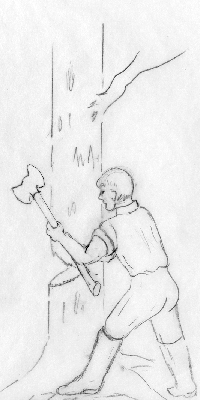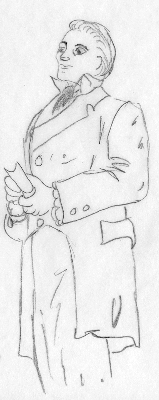Biographical sketch of Orville Sutherland Cox, continued
2 Frontier
A free boy! For now he was sure pursuit would not overtake him. His passenger called “What shall I do with this canoe?” “Keep her or let her float” shouted Cox. (If the owner of that dug-out will send in his bill for damages, O. S. Cox’s children will cheerfully settle.) As for food on this trip with the canoe, game was plentiful and he was a good shot. While on this boat he must have worked his passage, for he had no money.
On board that boat with a cargo of southern produce, he, for the first time in his life, saw an orange. He remained on this little river packet some distance up the river, then landed and found lucrative employment at lumbering and logging, and sometimes at the blacksmith’s forge. Soon he had the good luck to find his two brothers, Walter and Augustus, rafting logs down the river. He was an expert at this himself.
Now he learned that his mother, and her younger children, Amos, Harriet , Mary and Jonathan had gone to Ohio under the care of his older brother, William U., via the great world famous Erie Cana1; (at that time the largest canal in the world.) So by slow degrees and hard work he began to work his way toward Ohio. Usually he worked for lumber companies. His two brothers did likewise.

Orville met and loved Elvira in Far West, but was not baptized. He said he didn‘t propose to turn Mormon to procure a wife. When the Saints were driven from Missouri, he located near Lima, Illinois with a group of Mormons and helped build the Morley settlement.
Nearing his 24th birthday, he was a thorough frontiersman, forester, lumberman, a splendid blacksmith, a natural born engineer; in short a genuine and an all around good fellow. He was six feet in his socks and heavy proportionately.

The two newly weds, on October 6, 1839, drove into Nauvoo twenty miles away, and Orville S. Cox was baptized, by the Prophet Joseph Smith. He went a gentile and returned a full-fledged Mormon, so short a time it takes a woman to make a convert. He was a faithful L.D.S., full of love and zeal- He was a member of the famous brass band of the Nauvoo Legion. When the prophet and his brother were killed, none mourned more sincerely than he. He assisted those more helpless or destitute in the migration from Nauvoo. His stacks of grain were burned at the Morley settlement by the mobbers, and they fled to the City of Nauvoo, he with his wife and two children-- the oldest child had died when an infant as a result of its mother having chills an fever, and from exposure resulting from mobbers violence.
He attended the meeting where Sidney Rigdon asked the Saints to appoint him as guardian, and where Brigham Young claimed that the Twelve Apostles were the ordained leaders; and many times thereafter he testified that he saw Brigham Young changed to appear like Joseph and heard his voice take on the Prophet's tone. And after that manifestation he never doubted for a moment that the rightful leadership of the Church was vested in the twelve, with Brigham Young at their head. He remained in Nauvoo till almost the last departed. He assisted Browning in transforming the old rusty steamer shafts into cannons that were so effectually used by Daniel H. Wells at the Battle of Nauvoo.
Leaving Nauvoo with the last of the Mormon exiles, he crossed Iowa and settled at Pisgah, where he served as counselor to Lorenzo Snow, President at Mt. Pisgah. In his devoted attachment to Lorenzo Snow, he was an enthusiast; Also to Father Morley and he would follow their leadership anywhere. Orville and Elvira had their two children, Almer and Adelia.